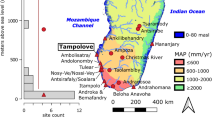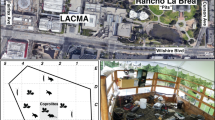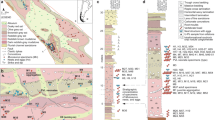Abstract
Mollusc shells are a vital but sometimes scarce resource for hermit crabs, protecting them from mechanical damage and desiccation, but they require continual replacement as the crab grows. I have discovered that Coenobita rugosus, a large, tropical, semi-terrestrial hermit crab, will resort to using fossil shells when no other suitable casing is available. These unlikely mobile homes fall out of coastal limestone as it is eroded by the sea in southwestern Madagascar, placing the occupants alongside Homo sapiens as resourceful exploiters of prehistoric animal remains.
This is a preview of subscription content, access via your institution
Access options
Subscribe to this journal
Receive 51 print issues and online access
$199.00 per year
only $3.90 per issue
Buy this article
- Purchase on Springer Link
- Instant access to full article PDF
Prices may be subject to local taxes which are calculated during checkout


Similar content being viewed by others
References
Reese, E. S. Anim. Behav . 10, 347–360 (1962).
Hazlett, B. A. Behav. Ecol. Sociobiol. 6, 177–184 (1980).
Rutherford, J. D. Veliger 19, 438–439 (1977).
Bertness, M. D. J. Exp. Mar. Biol. Ecol. 64, 159–187 (1982).
Burggren, W. W. & McMahon, B. R. Biology of the Land Crabs (Cambridge Univ. Press, Cambridge, 1988).
Fotheringham, N. Ecology 57, 570–578 (1976).
Kellogg, C. W. J. Exp. Mar. Biol. Ecol. 22, 101–111 (1976).
Barnes, D. K. A., Corrie, A., Whittington, M., Carvelho, M. A. & Gell, F. J. Shellfish Res. 17, 51–58 (1998).
Barnes, D. K. A., Rawlinson, K., Zucco, C., Lawford, L. & Purnell, L. in Ecology and Biodiversity of Madagascar, a Contribution from Ireland (eds Barnes, D. K. A. & Sleeman, D. P.) (Irish Biogeogr. Soc., in the press).
Author information
Authors and Affiliations
Corresponding author
Rights and permissions
About this article
Cite this article
Barnes, D. Ancient homes for hard-up hermit crabs. Nature 412, 785–786 (2001). https://doi.org/10.1038/35090632
Issue Date:
DOI: https://doi.org/10.1038/35090632
This article is cited by
Comments
By submitting a comment you agree to abide by our Terms and Community Guidelines. If you find something abusive or that does not comply with our terms or guidelines please flag it as inappropriate.



